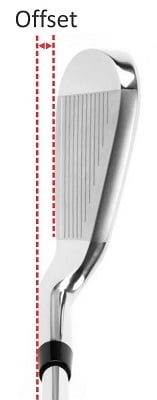
There are a few clubhead design parameters that influence ball flight and trajectory. These terms are face progression, offset and onset, which are either foreign to the average golfer or at least confusing at best.
Golf Club Face Progression
Before we explain what offset golf clubs are, let’s help sort out these terms. Golf club offset, onset and face progression are all related to one another as they share an established a point of reference, which is the centerline axis of the shaft (indicated by the white dotted line labeled #1).
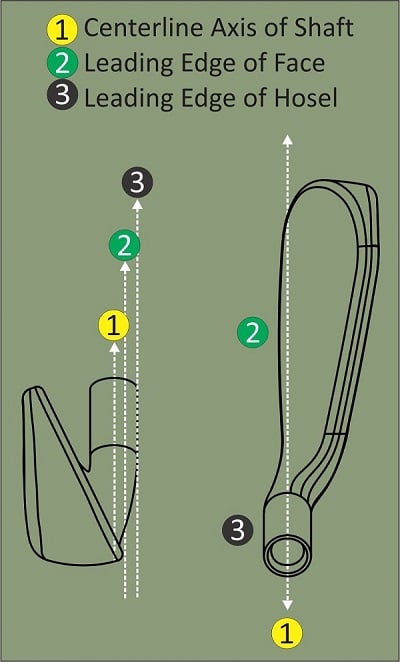
Golf clubs are measured by foundries and golf club manufacturers using heavy duty industrial specification gauges. The base of a specs (for short) gauge has a series of lines engraved, one of which shows how the vertical centerline of the shaft translates to the horizontal plane as a means of referencing many things about a golf club.
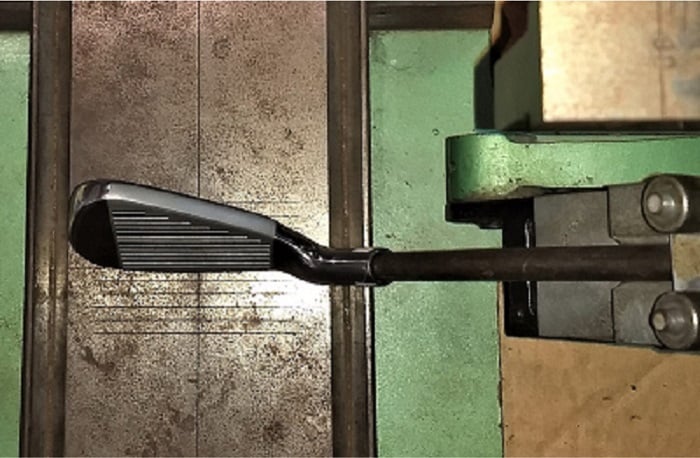
One of these is face progression which is simply the measurement from the center line axis of the shaft (#1) to the leading edge of the club face (#2). The difference between the two lines is the face progression.
Golf club offset explained
A term that is commonly used to describe golf irons and wedges is offset. Offset is somewhat like face progression as the leading edge of the face (#2) is used as a reference point.
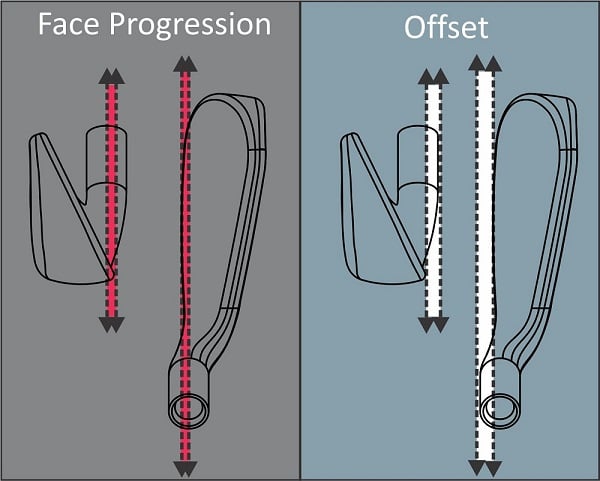
We define golf club offset as the distance between the forward most or leading edge of the hosel (#3) and the leading edge of the face (#2).
The red shaded areas show the amount of face progression verses the iron offset (white shaded area) using the same iron head example.
Nearly all irons on the market possess offset, which is considered a game improvement feature. Blade style wedges are probably one of the few examples of a zero offset iron or a no offset iron where the leading edge of the hosel and the face coincide.
Onset golf clubs
For the most part, the leading edge of the hosel of an iron is in front of the leading edge of the face, which is offset. If the opposite was to occur, as in rare instances, this will be called onset. Onset is negative offset and in iron design may be called a face-forward design. We will talk about onset more when discussing woods and hybrids.
Converting offset measurements
Manufacturers will vary in providing you with their offset measurements. In some cases, the offset iron units are in inches and others are in millimeters (mm). Inches are easily converted to millimeters by simply multiplying by 25.4 or to convert millimeters to inches, you divide by 25.4.
Hosel diameter affects golf club offset
Some Japanese manufacturers have eliminated the use of offset altogether and simply gone to face progression in their listed specifications. Therefore, it is important to understand these differences. The reason why is offset is unfortunately directly related to the outside diameter of the golf club hosel, unlike face progression, which has one standard reference point. Not all irons will have the same outside hosel diameter due to the material they are made from and the diameters necessary to provide enough strength.
The modern irons made from grades of either stainless or carbon steel will typically have an outside diameter (OD) of 0.535” (13.59mm) with a plus or minus tolerance 0.005” (0.13mm). There are a few iron heads made of zinc (found primarily in starter sets) may have a hosel OD closer to 0.560” (14.22mm). An identical head made of zinc will make the club appear as it has additional offset, even though the face progression would be the same as that same iron with a conventional hosel OD.
Progressive Offset
Listed in the following tables are typical amounts of offset in a game improvement and a player's iron set. We also converted the iron offset to face progression (F.P. for short). We call the following as progressive offset golf clubs because offset varies from one club to the next by gradually decreasing the offset as the club becomes shorter.
|
Game Improvement Iron |
||||
|
Iron |
Offset |
Offset |
F.P. |
F.P. |
|
|
mm |
inches |
mm |
inches |
|
#3 |
8.0 |
0.315 |
-1.2 |
-0.047 |
|
#4 |
7.5 |
0.295 |
-0.7 |
-0.028 |
|
#5 |
7.0 |
0.276 |
-0.2 |
-0.008 |
|
#6 |
6.5 |
0.256 |
0.3 |
0.012 |
|
#7 |
6.0 |
0.236 |
0.8 |
0.031 |
|
#8 |
5.5 |
0.217 |
1.3 |
0.051 |
|
#9 |
5.0 |
0.197 |
1.8 |
0.071 |
|
PW |
4.5 |
0.177 |
2.3 |
0.091 |
|
SW |
4.0 |
0.157 |
2.8 |
0.110 |
|
Player's Iron |
||||
|
Iron |
Offset |
Offset |
F.P. |
F.P. |
|
|
mm |
inches |
mm |
inches |
|
#3 |
3.4 |
0.134 |
3.4 |
0.134 |
|
#4 |
3.3 |
0.130 |
3.5 |
0.138 |
|
#5 |
3.2 |
0.126 |
3.6 |
0.142 |
|
#6 |
3.0 |
0.118 |
3.8 |
0.150 |
|
#7 |
2.8 |
0.110 |
4.0 |
0.157 |
|
#8 |
2.6 |
0.102 |
4.2 |
0.165 |
|
#9 |
2.3 |
0.091 |
4.5 |
0.177 |
|
PW |
2.2 |
0.087 |
4.6 |
0.181 |
|
SW |
2.2 |
0.087 |
4.6 |
0.181 |
Let's first start out explaining offset with the game improvement set. In a normal game-improvement set of irons, you might see the face progression starts with the leading edge of the face is rearward of the center line axis of the shaft and eventually moves forward. In this set, the #5 and 6 irons will have the leading edge appear almost directly in line with the shaft.
In an iron design for a more skilled golfer, the set is often designed with less or reduced offset. Even there, you find that more offset is designed into the longer irons (where it is needed most) than the shorter irons and wedges which are easier to square up at impact.
Offset drivers, fairways, and hybrid clubs
In the diagram, we have two identical driver heads except the one on the top is a straight neck driver and the one below is an offset driver. When we talk about offset, rarely do we list as a specification the offset of a wood shaped club (driver, fairway wood, or hybrid). There is a good reason why.
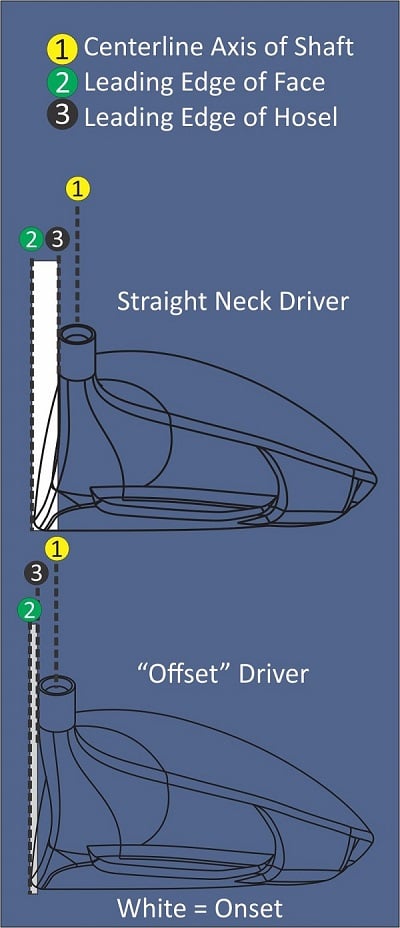
Technically those claiming to have offset aren’t offset at all. Sure, they may have a gooseneck hosel feature, but probably better terminology would be semi-offset or reduced onset. As you can see from the diagram from the heel view, the leading edge of the face of the “offset” driver is still forward of the leading edge of the hosel.
For more information about offset, benefits, and how offset works, consult the Modern Guide to Golf Clubfitting book.
Related articles
Understanding and Measuring Gravity Angle on Golf Clubs
How To Align a Curved Putter Shaft

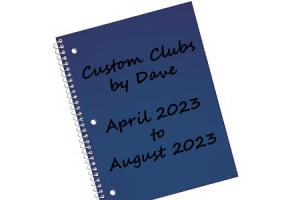
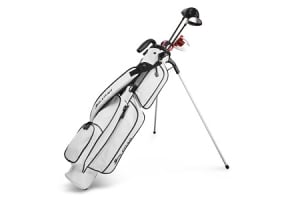
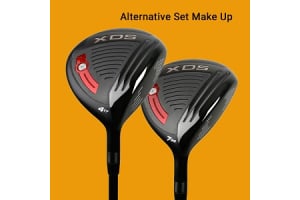


At the present time, we do not offer the service of pre-bending the lie of an iron ahead of shipping.